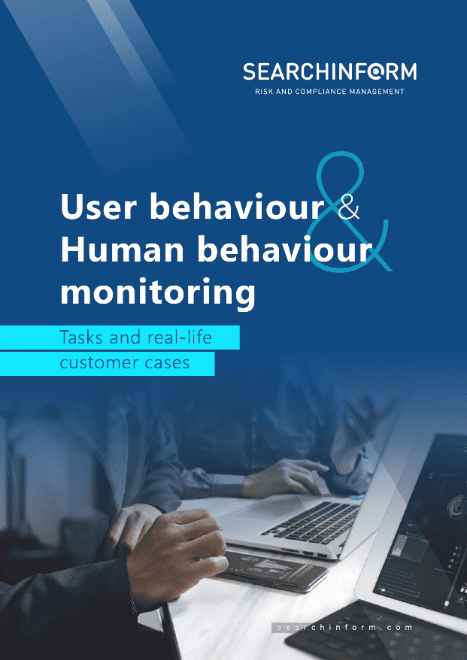Insider Threat Prevention: Safeguarding Your Business
- Introduction to Insider Threat Prevention
- Understanding Insider Threats
- Key Components of an Insider Threat Program
- Technology's Role in Insider Threat Prevention
- Insider Threat Prevention Strategies and Best Practices
- Establishing Clear Policies and Procedures
- Implementing Robust Access Controls
- Leveraging Advanced Monitoring and Detection Tools
- Developing a Comprehensive Incident Response Plan
- Fostering a Security-Conscious Culture
- Utilizing Data Loss Prevention (DLP) Technologies
- Continuous Training and Education
- Regular Audits and Compliance Checks
- Integrating Behavioral Analytics
- Secure Collaboration and Communication Tools
- Employee Monitoring and Privacy Balance
- Psychological and Behavioral Assessments
- Enhanced Physical Security Measures
- Secure Offboarding Processes
- Cross-Departmental Collaboration
- Leveraging Threat Intelligence
- Continuous Improvement and Adaptation
- Technology Solutions for Insider Threat Prevention
- Advanced Monitoring and Analytics
- Data Loss Prevention (DLP) Technologies
- Access Control and Identity Management
- Endpoint Detection and Response (EDR)
- Secure Collaboration Tools
- Artificial Intelligence and Machine Learning
- Secure Offboarding Solutions
- Continuous Improvement and Integration
- The Advantages of SearchInform’s Solutions in Insider Threat Prevention
- Comprehensive Data Visibility and Monitoring
- Real-time Alerting and Incident Response
- Advanced User Behavior Analytics
- Comprehensive Data Loss Prevention (DLP)
- Regulatory Compliance and Audit Support
- Streamlined Investigation and Forensics Capabilities
- Insider Threat Intelligence and Trend Analysis
- Scalability and Customization Options
- User-friendly Interface and Intuitive Dashboards
- Continuous Support and Updates
Introduction to Insider Threat Prevention
In today's digital age, safeguarding organizational assets against internal threats is as critical as defending against external attacks. Insider threat prevention encompasses a range of strategies and practices designed to mitigate risks posed by individuals within the organization. These threats can stem from malicious intent, negligence, or even simple human error, making a robust insider threat prevention program essential for any modern enterprise.
Understanding Insider Threats
Insider threats can be categorized into various types, each requiring different approaches for effective management. Malicious insiders, for instance, deliberately misuse their access to harm the organization. This can include data theft, espionage, or sabotage. On the other hand, unintentional insiders might inadvertently expose sensitive information or create security vulnerabilities through careless actions, such as clicking on phishing links or mishandling confidential data.
Key Components of an Insider Threat Program
To effectively prevent insider threats, organizations need to implement a comprehensive insider threat program. This typically includes several key components:
- Policy and Training: Establishing clear policies regarding data access and handling, coupled with regular training sessions to educate employees about the importance of cybersecurity and the potential consequences of insider threats.
- Access Controls: Implementing strict access controls to ensure that employees only have access to the information necessary for their roles. This involves using principles like the least privilege and need-to-know basis.
- Monitoring and Detection: Utilizing advanced monitoring tools to detect unusual or unauthorized activities within the network. This includes both technical solutions, such as intrusion detection systems, and behavioral analytics to identify patterns indicative of insider threats.
- Incident Response: Developing and maintaining an incident response plan to swiftly address and mitigate the impact of any insider threat incidents. This plan should outline clear steps for investigation, containment, and recovery.
Technology's Role in Insider Threat Prevention
Advanced technologies play a crucial role in enhancing insider threat prevention measures. Machine learning and artificial intelligence, for example, can analyze vast amounts of data to identify anomalies that might suggest insider activity. Additionally, Data Loss Prevention (DLP) systems help to ensure that sensitive information does not leave the organization's control without authorization.
Insider threat prevention is a multifaceted endeavor requiring a combination of policies, technologies, and a culture of security awareness. By understanding the different types of insider threats and implementing comprehensive prevention strategies, organizations can protect themselves from potentially devastating internal breaches. As the landscape of threats continues to evolve, so too must the approaches to managing them, ensuring that organizations remain resilient in the face of both internal and external challenges.
Insider Threat Prevention Strategies and Best Practices
Insider threat prevention is a critical component of any organization's security framework. Effective strategies encompass a blend of policy enforcement, technological solutions, and fostering a culture of vigilance. Understanding and implementing these strategies can significantly reduce the risk of damage caused by insiders, whether their actions are intentional or accidental.
Establishing Clear Policies and Procedures
The foundation of any insider threat prevention strategy is the establishment of clear, comprehensive policies and procedures. These should outline acceptable use of organizational resources, data handling protocols, and the consequences of policy violations. Regularly updating these policies to address emerging threats and changes in the organizational structure is essential. Additionally, it is vital to ensure that all employees, from new hires to senior management, are aware of and understand these policies. Regular training sessions, supplemented by easy-to-access documentation, can reinforce this understanding and highlight the importance of adherence.
Implementing Robust Access Controls
Access control mechanisms are crucial in limiting the potential damage an insider can cause. Adopting the principle of least privilege, which ensures that employees have access only to the information necessary for their job functions, is a key tactic. Role-based access controls (RBAC) can further refine these permissions, making it easier to manage and monitor who has access to what data. Moreover, periodic reviews and audits of access permissions can help identify and rectify any discrepancies, ensuring that access rights remain appropriate over time.
Leveraging Advanced Monitoring and Detection Tools
Technological solutions play a pivotal role in identifying and mitigating insider threats. Employing advanced monitoring tools that track user activity can provide early warnings of suspicious behavior. For instance, user and entity behavior analytics (UEBA) can detect anomalies by comparing current activities to established behavioral baselines. Similarly, Security Information and Event Management (SIEM) systems can aggregate and analyze log data from various sources, providing a comprehensive view of network activity and highlighting potential insider threats. These tools, combined with real-time alerts, enable security teams to respond swiftly to potential incidents.
Developing a Comprehensive Incident Response Plan
An effective insider threat prevention strategy must include a well-defined incident response plan. This plan should detail the steps to take when an insider threat is detected, including identification, containment, investigation, and remediation processes. Having a clear response protocol not only helps in mitigating the impact of an insider incident but also ensures that the organization can recover quickly and maintain operational continuity. Regular drills and simulations of insider threat scenarios can help prepare the response team and identify any weaknesses in the plan.
Fostering a Security-Conscious Culture
Creating a culture of security within the organization is one of the most effective ways to prevent insider threats. This involves encouraging employees to take ownership of their role in protecting the organization’s assets and fostering an environment where security is a shared responsibility. Regular communication about the importance of security, along with recognition of employees who adhere to best practices, can reinforce this culture. Additionally, establishing anonymous reporting channels for suspicious behavior can empower employees to act without fear of retribution.
Utilizing Data Loss Prevention (DLP) Technologies
Data Loss Prevention (DLP) technologies are essential tools in the arsenal against insider threats. These systems monitor and control the movement of sensitive data across the organization’s network, preventing unauthorized access and exfiltration. By setting up rules and policies within the DLP system, organizations can ensure that critical information does not leave the network without proper authorization. DLP tools can also provide insights into data usage patterns, helping to identify potential risks and enforce compliance with data protection regulations.
Continuous Training and Education
Ongoing education and training are vital for keeping employees aware of the latest threats and security best practices. Regular workshops, seminars, and e-learning modules can help keep security top of mind. This continuous education ensures that employees are equipped with the knowledge to recognize and respond to potential threats, reducing the likelihood of accidental breaches. Furthermore, specialized training for different roles can address specific risks and responsibilities, making the security program more effective overall.
Regular Audits and Compliance Checks
To maintain a high level of security, regular audits and compliance checks are essential. These audits help to ensure that all security policies and access controls are being followed correctly. They also identify any lapses or areas of improvement within the organization’s security framework. Compliance checks, particularly for industries subject to stringent regulations like healthcare and finance, ensure that the organization adheres to relevant laws and standards. Conducting both internal and external audits provides a comprehensive assessment of the security posture and helps in uncovering hidden vulnerabilities.
Integrating Behavioral Analytics
Behavioral analytics is a powerful tool in the fight against insider threats. By establishing a baseline of normal user behavior, these analytics can detect deviations that might indicate a potential threat. For example, if an employee who typically accesses certain files during specific hours suddenly begins downloading large amounts of sensitive data at odd times, this could trigger an alert for further investigation. Integrating behavioral analytics with existing security infrastructure enhances the ability to detect and respond to insider threats proactively.
Secure Collaboration and Communication Tools
As remote work becomes more prevalent, securing collaboration and communication tools is increasingly important. Organizations must ensure that the platforms used for internal communication, file sharing, and collaboration are secure and compliant with their security policies. Implementing encryption, multi-factor authentication, and secure VPNs can protect against unauthorized access and eavesdropping. Additionally, monitoring these tools for unusual activity can help detect potential insider threats in a remote work environment.
Employee Monitoring and Privacy Balance
While monitoring employee activities is crucial for detecting insider threats, it is important to balance this with respect for employee privacy. Transparent policies about what is being monitored and why can help maintain trust within the organization. Employers should ensure that monitoring practices comply with legal standards and are conducted ethically. Striking this balance helps in maintaining a positive work environment while still protecting the organization from insider threats.
Psychological and Behavioral Assessments
Incorporating psychological and behavioral assessments into the hiring and ongoing evaluation processes can help identify individuals who may pose a higher risk of becoming insider threats. These assessments can uncover traits such as a propensity for dishonesty, dissatisfaction with the organization, or other risk factors. By understanding the psychological profile of employees, organizations can tailor their insider threat prevention strategies more effectively. Offering support programs for employees facing personal or professional challenges can also mitigate the risk of them turning into insider threats.
Enhanced Physical Security Measures
Physical security should not be overlooked in an insider threat prevention strategy. Unauthorized physical access to sensitive areas can lead to significant security breaches. Implementing measures such as badge access controls, security cameras, and regular security patrols can help prevent unauthorized physical access. Additionally, ensuring that physical security policies are in sync with digital security measures creates a comprehensive defense system.
Secure Offboarding Processes
The offboarding process for departing employees or contractors is a critical time for insider threat prevention. Ensuring that access to all company systems and data is promptly revoked is essential to prevent any potential misuse of information. Conducting an exit interview can provide insights into any grievances that might lead to malicious actions. Additionally, ensuring that data belonging to the departing employee is securely transferred or deleted helps maintain data integrity and security.

Cross-Departmental Collaboration
Insider threat prevention should not be the sole responsibility of the IT or security department. Cross-departmental collaboration is vital for a holistic approach. Human Resources can provide insights into employee behavior and morale, Legal can ensure compliance with laws and regulations, and Operations can assist with implementing physical security measures. Regular meetings and communication between these departments can enhance the overall effectiveness of the insider threat prevention program.
Leveraging Threat Intelligence
Utilizing threat intelligence can provide valuable insights into potential insider threats. By staying informed about the latest tactics, techniques, and procedures (TTPs) used by insiders, organizations can better prepare and defend against such threats. Threat intelligence can be gathered from various sources, including industry reports, security forums, and collaboration with other organizations. Integrating this intelligence into the organization’s security strategy helps in anticipating and mitigating insider threats more effectively.
Continuous Improvement and Adaptation
The landscape of insider threats is constantly evolving, requiring organizations to continuously improve and adapt their prevention strategies. Regularly reviewing and updating security policies, incorporating new technologies, and learning from past incidents are crucial for staying ahead of potential threats. Engaging in continuous improvement ensures that the insider threat prevention program remains effective and resilient against new and emerging threats.
Insider threat prevention requires a holistic and ongoing approach that integrates policies, technological solutions, and a proactive security culture. By establishing clear policies, implementing robust access controls, leveraging advanced monitoring tools, and fostering a security-conscious culture, organizations can significantly mitigate the risks posed by insider threats. Continuous training, a well-defined incident response plan, and a commitment to continuous improvement further enhance the organization’s ability to prevent and respond to insider incidents. A proactive and comprehensive approach, involving all levels of the organization, is essential to ensure long-term security and resilience, protecting against the potentially devastating impact of insider threats.
Technology Solutions for Insider Threat Prevention
In the digital era, technology plays a pivotal role in fortifying organizations against insider threats. Leveraging advanced tools and systems can provide early detection, monitoring, and mitigation of potential risks posed by insiders. Integrating these technologies into a comprehensive security strategy ensures a robust defense against both malicious and unintentional insider activities.
Advanced Monitoring and Analytics
One of the cornerstones of effective insider threat prevention is advanced monitoring and analytics. Tools such as Security Information and Event Management (SIEM) systems aggregate data from various sources, providing a unified view of network activities. SIEM systems analyze logs and generate real-time alerts for suspicious activities, allowing security teams to respond swiftly. User and Entity Behavior Analytics (UEBA) further enhance this capability by establishing baselines of normal behavior and identifying anomalies that deviate from these patterns. For instance, if an employee who typically accesses data during business hours suddenly begins downloading large amounts of sensitive information at midnight, UEBA would flag this as unusual activity requiring further investigation.
Data Loss Prevention (DLP) Technologies
Data Loss Prevention (DLP) technologies are essential in protecting sensitive information from unauthorized access or exfiltration. DLP systems monitor and control data flows within the organization, ensuring that confidential data does not leave the network without proper authorization. These systems can enforce policies that prevent copying sensitive data to external drives or sending it through unsecured email. By implementing DLP technologies, organizations can significantly reduce the risk of data breaches caused by insider actions, whether intentional or accidental.
Access Control and Identity Management
Robust access control mechanisms are critical in limiting insider threats. Implementing Role-Based Access Control (RBAC) ensures that employees have access only to the information necessary for their job functions. This minimizes the risk of unauthorized access to sensitive data. Additionally, Identity and Access Management (IAM) solutions help manage user identities and their access rights across the organization. Multi-factor authentication (MFA) adds an extra layer of security, making it more difficult for unauthorized individuals to gain access to critical systems and data.
Endpoint Detection and Response (EDR)
Endpoint Detection and Response (EDR) solutions provide continuous monitoring and analysis of endpoints, such as computers and mobile devices, to detect and respond to cyber threats. EDR tools collect data from endpoints and use machine learning algorithms to identify suspicious behavior. When a potential threat is detected, EDR solutions can isolate the affected device, contain the threat, and initiate an automated response. This rapid detection and response capability is crucial for mitigating the impact of insider threats that may originate from compromised endpoints.
Secure Collaboration Tools
As remote work becomes increasingly common, secure collaboration tools are vital for maintaining security. Platforms for communication and file sharing must be secured with encryption and robust access controls to prevent unauthorized access. Implementing virtual private networks (VPNs) ensures that remote connections are secure and that data transmitted between remote employees and the organization is protected. Monitoring these tools for unusual activities can help detect potential insider threats in a remote work environment, ensuring that the organization's security posture remains strong despite the physical separation of its workforce.
Artificial Intelligence and Machine Learning
Artificial Intelligence (AI) and Machine Learning (ML) technologies are transforming insider threat prevention. These technologies can process vast amounts of data and identify complex patterns that might be indicative of insider threats. AI-driven systems can predict potential threats by analyzing behavioral patterns and providing actionable insights. For example, if an AI system detects that an employee is accessing sensitive files more frequently than usual and correlates this with other risk indicators, it can alert the security team to a potential insider threat. The predictive capabilities of AI and ML make them invaluable tools in preemptively identifying and mitigating risks.
Secure Offboarding Solutions
Ensuring that the offboarding process is secure is a crucial aspect of insider threat prevention. When an employee leaves the organization, it is essential to revoke their access to all systems and data immediately. Automated offboarding solutions can streamline this process by ensuring that access rights are promptly removed and that any company-owned devices are returned and secured. Additionally, secure data transfer protocols should be in place to handle any data that the departing employee was responsible for, ensuring that it remains protected even after they leave.
Its discovery entails:
Continuous Improvement and Integration
The landscape of insider threats is constantly evolving, necessitating continuous improvement and integration of new technologies. Organizations should regularly assess their technology solutions and update them to address emerging threats. Integrating new tools with existing security infrastructure ensures a cohesive and comprehensive defense strategy. Continuous improvement involves not only adopting new technologies but also refining existing processes and policies to enhance overall security.
Technology solutions are indispensable in the battle against insider threats. By implementing advanced monitoring and analytics, data loss prevention systems, robust access controls, and secure collaboration tools, organizations can significantly enhance their ability to detect, prevent, and respond to insider threats. Leveraging artificial intelligence and machine learning further strengthens these defenses, providing predictive insights and rapid response capabilities. A commitment to continuous improvement and integration of new technologies ensures that organizations remain resilient against evolving threats, safeguarding their assets and maintaining operational integrity.
The Advantages of SearchInform’s Solutions in Insider Threat Prevention
SearchInform offers a range of innovative solutions designed to bolster organizations' defenses against insider threats. Leveraging advanced technologies and robust features, SearchInform's solutions provide numerous benefits for proactive insider threat prevention and mitigation.
Comprehensive Data Visibility and Monitoring
One of the primary benefits of SearchInform's solutions is the comprehensive visibility they provide into an organization's data landscape. Through advanced monitoring capabilities, our solutions track and analyze user activities across various endpoints and data repositories. This deep insight enables organizations to identify anomalous behavior indicative of insider threats, such as unauthorized access to sensitive information or suspicious data exfiltration attempts.
Real-time Alerting and Incident Response
SearchInform's solutions empower organizations to respond swiftly to insider threats with real-time alerting and incident response capabilities. By setting up custom alerts based on predefined security policies and behavioral patterns, security teams can receive instant notifications of potential threats. This proactive approach allows for immediate intervention to contain and mitigate the impact of insider incidents, minimizing damage to the organization's assets and reputation.
Advanced User Behavior Analytics
Utilizing advanced user behavior analytics, SearchInform's solutions can detect subtle deviations from normal user behavior that may indicate insider threats. By establishing baseline behavioral profiles for individual users, our solutions can identify anomalous activities, such as unusual file access patterns or data manipulation, that may signify malicious intent or compromised credentials. This granular insight enables organizations to preemptively thwart insider threats before they escalate into full-blown security breaches.
Comprehensive Data Loss Prevention (DLP)
SearchInform's solutions include robust data loss prevention (DLP) features to safeguard sensitive information from unauthorized access, sharing, or exfiltration. By implementing policy-based controls and encryption mechanisms, our solutions ensure that critical data remains protected throughout its lifecycle. Whether data is at rest, in transit, or in use, SearchInform's DLP capabilities provide organizations with the assurance that their most valuable assets are secure from insider threats.
Regulatory Compliance and Audit Support
In addition to bolstering security measures, SearchInform's solutions assist organizations in meeting regulatory compliance requirements and facilitating audit processes. With built-in reporting and auditing functionalities, our solutions enable organizations to demonstrate adherence to industry-specific regulations and standards. By maintaining a comprehensive audit trail of user activities and security events, organizations can satisfy compliance mandates while also enhancing their overall security posture.
Streamlined Investigation and Forensics Capabilities
SearchInform's solutions streamline the investigation and forensics process following insider threat incidents. With powerful search and indexing functionalities, security teams can quickly pinpoint relevant data and conduct in-depth investigations into suspicious activities. Our solutions provide forensic analysis tools that enable organizations to reconstruct incident timelines, gather evidence, and determine the root cause of insider threats. By expediting the investigative process, SearchInform's solutions minimize the impact of insider incidents and facilitate swift remediation efforts.
Insider Threat Intelligence and Trend Analysis
By leveraging data gathered from insider threat incidents, SearchInform's solutions offer valuable intelligence and trend analysis capabilities. Our solutions aggregate and analyze security event data to identify common trends, patterns, and emerging threats related to insider activity. By understanding the evolving tactics and techniques employed by insiders, organizations can proactively adjust their security strategies and defenses to stay ahead of potential threats. SearchInform's insider threat intelligence empowers organizations to make informed decisions and adapt their security posture to mitigate future risks effectively.
Scalability and Customization Options
SearchInform's solutions are highly scalable and customizable, making them suitable for organizations of all sizes and industries. Whether deployed in small businesses or large enterprises, Our solutions can be tailored to meet specific security requirements and operational needs. From fine-tuning alerting thresholds to customizing user access controls, organizations have the flexibility to configure SearchInform's solutions according to their unique environments. This scalability and customization ensure that organizations can effectively address insider threats while accommodating growth and evolving business requirements.
User-friendly Interface and Intuitive Dashboards
SearchInform's solutions feature a user-friendly interface and intuitive dashboards that empower security teams with actionable insights and visibility into insider threat activities. Through visually engaging dashboards and reports, security professionals can easily monitor key security metrics, track incident trends, and identify areas of concern. The intuitive interface simplifies the navigation and configuration of SearchInform's solutions, enabling security teams to efficiently manage insider threat prevention efforts without extensive training or technical expertise.
Continuous Support and Updates
SearchInform provides continuous support and updates for its solutions, ensuring that organizations receive ongoing assistance and access to the latest features and capabilities. With dedicated customer support teams and regular software updates, organizations can rely on SearchInform to address any issues promptly and keep their insider threat prevention systems up to date. This commitment to customer satisfaction and product excellence reinforces organizations' confidence in SearchInform's solutions as a reliable and effective defense against insider threats.
SearchInform's solutions provide organizations with a multifaceted and comprehensive approach to insider threat prevention. Offering features such as comprehensive data visibility, real-time alerting, advanced user behavior analytics, robust DLP capabilities, and support for regulatory compliance and audits, SearchInform equips organizations with the tools necessary to proactively identify, mitigate, and prevent insider threats. Additionally, SearchInform's suite of features, including scalability, customization options, user-friendly interfaces, and continuous support, ensures that organizations can effectively address the complex challenges of insider threat prevention while safeguarding their sensitive data and assets. With SearchInform's solutions, organizations can maintain operational continuity and stay one step ahead in the ongoing battle against insider threats.
Take proactive steps to safeguard your sensitive data, maintain operational continuity, and stay ahead in the ongoing battle against insider threats. Reach out to SearchInform now to discover how their innovative technologies can elevate your security posture.
Full-featured software with no restrictions
on users or functionality
Company news
SearchInform uses four types of cookies as described below. You can decide which categories of cookies you wish to accept to improve your experience on our website. To learn more about the cookies we use on our site, please read our Cookie Policy.
Necessary Cookies
Always active. These cookies are essential to our website working effectively.
Cookies does not collect personal information. You can disable the cookie files
record
on the Internet Settings tab in your browser.
Functional Cookies
These cookies allow SearchInform to provide enhanced functionality and personalization, such as remembering the language you choose to interact with the website.
Performance Cookies
These cookies enable SearchInform to understand what information is the most valuable to you, so we can improve our services and website.
Third-party Cookies
These cookies are created by other resources to allow our website to embed content from other websites, for example, images, ads, and text.
Please enable Functional Cookies
You have disabled the Functional Cookies.
To complete the form and get in touch with us, you need to enable Functional Cookies.
Otherwise the form cannot be sent to us.

Subscribe to our newsletter and receive a bright and useful tutorial Explaining Information Security in 4 steps!

Subscribe to our newsletter and receive case studies in comics!







